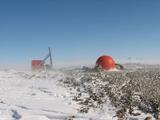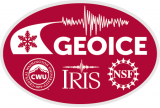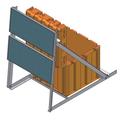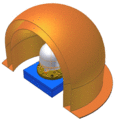
Seismic Sensor Vaults
The type of seismic sensor vault and the amount of sophistication it requires, is dependent on the type of seismometer. A geophone does not require a “vault” per se, it can be buried in dirt or snow and be kept reasonably level in the process. A sensitive broadband seismometer requires a quiet, temperature stable and level vault. In the Antarctic two main styles of vaults are used for broadband seismometers: the rock vault and the snow vault.
The Rock Vault
In rocky environments where digging is nearly impossible, a weatherproof enclosure with a rigid bottom, typically aluminium, is secured to the ground. The seismometer is then set inside, oriented properly and leveled.
To reduce noise caused by wind, and to thermally stabilize the vault and protect the instrument from flying debris, a double walled dome is placed on top of the vault and anchored to the ground as well.







